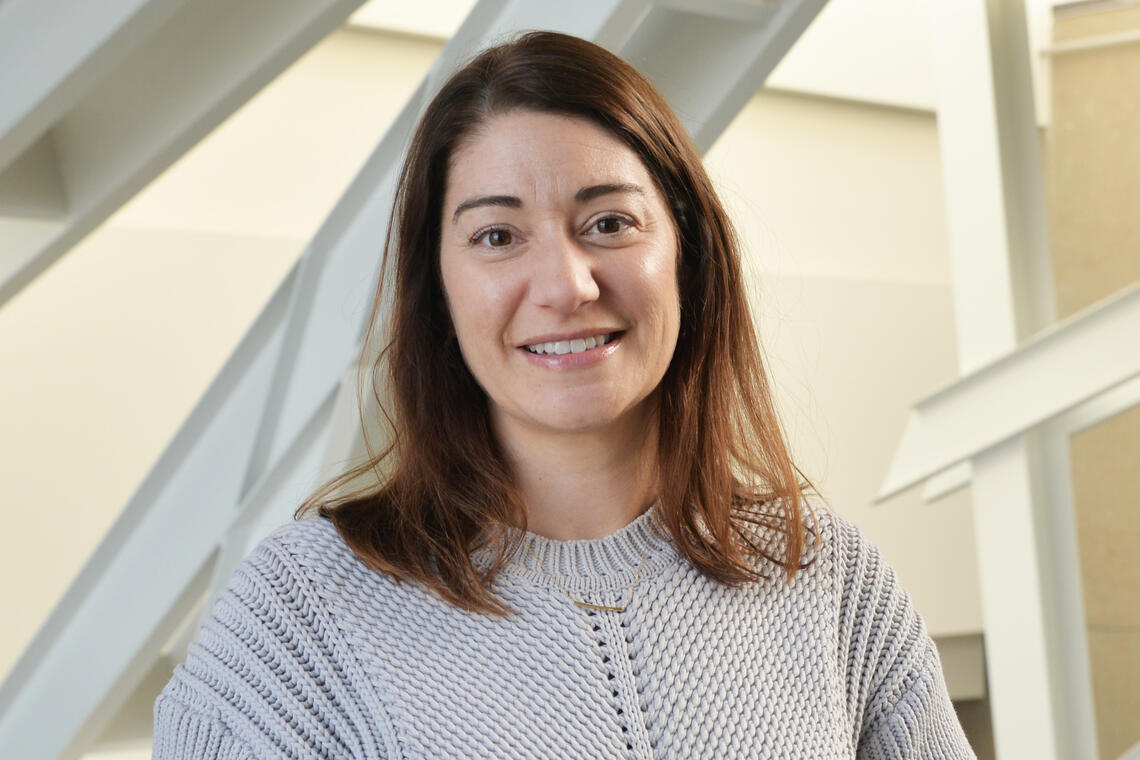Congratulations to Charbonneau Investigators on successful CIHR Spring 2024 Project Grants


Associate Professor, Department of Microbiology, Immunology and Infectious Diseases
Project Background:
Coronavirus nucleocapsid proteoforms inhibit antiviral biomolecular condensates
Viruses are small but mighty. Despite having tiny genomes, they make big changes in host cells, hijacking host cell machinery and stealing resources to copy the viral genome, produce viral proteins, and assemble these components into new viruses, all while evading highly sophisticated cellular surveillance systems. Viruses can multitask in this way by making proteins that have more than one function. A good example is the multifunctional nucleocapsid (N) protein of coronaviruses (CoVs). N protects the viral genome while supporting genome copying and packaging genomes into new viruses. N also suppresses cellular antiviral immune responses by inhibiting the function of cellular granules called processing bodies and stress granules. How can N have so many different roles, and how are these roles of the N protein regulated in space and time? Our lab's recent work has revealed the answer - N is not one protein, but rather a collection of proteins. We have discovered that for SARS-CoV-2, the cause of COVID-19, and common-cold CoVs, OC43 and 229E, N exists as an array of smaller truncated versions, as well as the full-length N protein. This means that some of the roles previously attributed to full-length N may be performed by truncated N proteins. We discovered that one truncated form of SARS-CoV-2 N decreases the cellular response to viral infection by causing processing body disassembly, blocking stress granules, and binding to double-stranded RNA in a manner distinct from its full-length parent N molecule. Our project will elucidate the role of CoV truncated N products during infection and define how these products inhibit cellular responses to viruses that are governed by antiviral granules. Together, this will reveal how truncated N production allows CoVs to make the most of their limited genetic capacity, enabling N to be 'everything, everywhere, all at once'.
Duration: 5 years

Professor, Department of Chemistry, Faculty of Science
Co-Investigators: Peter D. Tieleman, Tuan Trang
Project Background:
Development of Non-Opioid Therapeutics for the Treatment of Opioid Withdrawal and Addiction
The most recent data available from the Public Health Agency of Canada shows that a total of 3,970 apparent opioid-toxicity deaths occurred between January to June 2023 - approximately 22 deaths per day. In the same timeframe, 20,758 Emergency Medical Service responses occurred due to suspected opioid-related overdoses. This is a major impact on Canadian society. Despite the risks, individuals who are dependent on opioids face major challenges in achieving opioid abstinence due to the intense withdrawal symptoms that often occur. By reducing the effects of withdrawal, one of the major barriers to overcoming opioid dependence would be removed. Our team has discovered that pannexin-1 (Panx1) is a key determinant of opioid withdrawal and blocking this channel produces a striking alleviation of withdrawal. Blocking Panx1 reduces the severity of withdrawal symptoms. As known inhibitors of Panx1 have moderate potency and penetration into the brain, there is an urgent need to develop improved drugs targeting Panx1 to create therapeutics that treat opioid withdrawal. Preliminary work from our team has developed lead Panx1 inhibitors with significantly improved potency and drug-like properties. This proposal identifies three complementary strategies to create Panx1 inhibitors. We will use the tools of structure-based and ligand-based drug design, and reversible covalent inhibitors to aid in the development of new therapeutics. This proposal brings together an outstanding team including scientists with expertise in medicinal chemistry, molecular simulations, neuroscience, and structural biology. As the global health crisis of opioid-related deaths continues to grow, there is an urgency to improve treatment options. Our team will advance the development of a non-opioid option for the treatment of opioid withdrawal to help individuals break the cycle of drug dependence.

Professor, Department of Biochemistry & Molecular Biology
Project Background:
Cytokine signaling and the control of adaptive responses to hypoxia
Our cells and organs need oxygen from the air we breathe to survive and function. However, in disorders such as lung disease, stroke, and cancer, tissues are deprived of oxygen. This lack of oxygen, known as hypoxia, leads to the tissue damage and disruption that are characteristic of these diseases. Understanding how cells and tissues adapt their metabolism to respond to low oxygen is therefore an important question in biomedical research. Most of the research on hypoxia has been done using cells grown in lab dishes, which has given us important insights into how individual cells respond to low oxygen conditions. However, a crucial aspect that remains unanswered is how tissues and organisms as a whole cope with hypoxia. While all cells in animals can sense oxygen, whole-body reponses to hypoxia often involve communication and interaction between different cells and tissues. To understand these complex processes, we use fruit flies as a study system. Because they naturally grow and develop in decaying food, an environment characterized by low local oxygen levels, flies have evolved remarkable tolerance to low oxygen. We will therefore use the ease and speed of genetic manipulations in fruit flies to study how their tissues and organs are able to sense low oxygen and adapt their metabolism to be able to function and survive. Our project will specifically focus on understanding how organ-to-organ communication controls whole-body hypoxia adaptation. The processes that control metabolism and physiology are remarkably similar in flies and humans. Hence, in the long run our work may uncover ways to protect cells and tissues from the damage resulting from the oxygen deprivation seen in lung disease, stroke, and other disorders.
Duration: 5 years

Assistant Professor, Departments of Community Health Sciences, Surgery, and Oncology
Donna Manca
Professor, Faculty of Medicine & Dentistry - Family Medicine, University of Alberta
Co-Investigators: Shamir Chandarana, Julie Deleemans, Joseph Dort, Robyn Banerjee, Lauren Capozzi, Antoine Eskander, Kirsten Fiest, Robert Hart, Justin Lui, Daniel Niven, Anna Pujadas Botey
Project Background:
Co-designing better transitions in care for patients undergoing cancer treatment (CanTiC Tx)
Cancer treatment is complex; patients see many healthcare providers in many settings to receive life-saving treatments. When patients with cancer move between providers or settings care can break down and can compromise the care and health of patients with cancer. Patients with head and neck cancer move between a particularly high number of healthcare providers and healthcare settings (hospital, ICU, cancer centre) because of how complex their treatment is. Interventions have been shown to improve the continuity of care between healthcare providers and settings which increases the chance of having positive outcomes after cancer treatment. We will develop an evidence-based intervention (care bundle) with patients, healthcare providers and healthcare leaders to improve the continuity of care during cancer treatment for patients with head and neck cancer. We will use a formal process for engaging these groups to help develop the care bundle. Then we will prepare to test the care bundle to see if improves care, health and cancer outcomes, and satisfaction with care.
Duration: 2 years

Associate Professor, Departments of Oncology and Community Health Sciences
Professor, Department of Community Health Sciences
Jill Tinmouth
Professor, Department of Medicine, Temerty Faculty of Medicine, University of Toronto
Co-Investigators: Winson Cheung, Doreen Ezeife, Tamer Jarada, Jonathan Loree, Dylan O'Sullivan, Arlinda Ruco, Matthew Warkentin
Project Background:
The REFRAME Project- Rapid Evaluation FRAmework for the Modification of Cancer ScrEening Guidelines
Cancer screening has already saved the lives of hundreds of thousands of Canadians. However, who and how we screen for cancer has evolved over time. There are new tests, new needs, and new emerging disease trends. One example of these changes is the increase in early-onset colorectal cancer (eoCRC), among Canadians diagnosed before age 50 - the current recommended age to start screening. In the US, they have already revised their guidelines to screen at age 45 and in some cases as young as 40. In Canada, our healthcare system and how we run screening programs is very different than the US. Making a change to guidelines can have a major impact on scarce health resources, therefore many additional pieces of research and evidence are required for provinces and territories to make proper, informed decisions on whether they should change their screening programs. This grant would provide the evidence for these decisions using our Rapid Evaluation FRAmework for the Modification of Cancer ScrEening (REFRAME) Guidelines. In this project, we will develop the tools to generate the information needed for the provinces to make these types of decisions. We will develop several automated processes to rapidly synthesize what we know about the new questions in cancer screening, how much it would cost to make any changes, and what would be needed across provinces to enable these changes. For this project, we will use eoCRC as the lead example, but we will generate a sustainable, reproducible, and reusable tools that could be used to evaluate other screening changes such as for cervical, lung, breast, as new tests emerge and cancer trends change with our evolving population. Thus, the successful completion of this project has clear next steps and broad ongoing impact in cancer control. Upon the completion of this project, provinces would be equipped with the information they need to make important decisions for patients. REFRAME offers a short time-to-impact in cancer control.
Duration: 1 year


